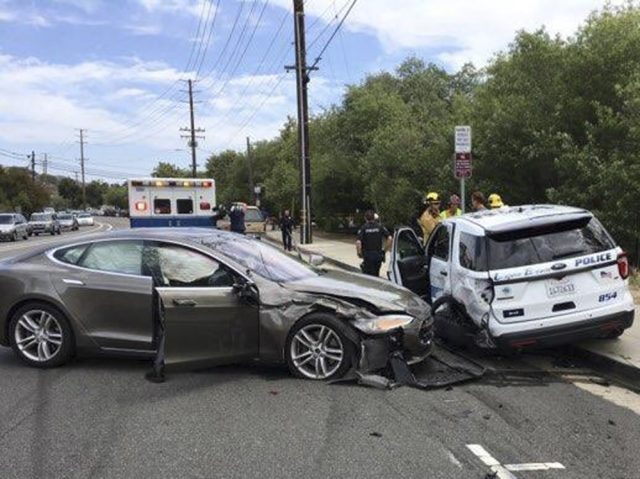A Tesla Model S sedan in self-driving mode veered into a parked police SUV in Laguna Beach, California, on Tuesday.
The Model S, operating in autopilot mode in light traffic and at a safe speed, self-veered at 11:07 a.m. into a parked and unoccupied police car in a non-residential area of Laguna Canyon Road, also known as California Highway 133.
According to a Los Angeles Times report, Laguna Police spokesman Sgt. Jim Cota stated the Tesla driver suffered only minor injuries and refused to be transported to Laguna Beach’s Mission Hospital. Sgt. Cota stated that the police unit was a total loss, but added: “Thankfully there was not an officer at the time in the police car.”
Tesla has won a string of five-star ratings from the National Transportation Safety Board (NTSB) over the last 6 years, but its Model 3, which was released nine months ago, was not rated. Nor were its 2018 Model S sedan and Model X SUV, which were released six months ago.
Tesla vehicles have accounted for 29 U.S. deaths since 2013, including 14 Tesla occupants, 11 occupants of other cars, and four pedestrians or cyclists.
Recent high visibility self-driving accidents involving Tesla vehicles have included: a Utah woman operating a Tesla Model S in autopilot last week while looking at the maps on her phone, who smashed into the back of a fire truck when the car self-accelerated; and a Tesla Model X also operating in autopilot that drove into a concrete median near Mountain View, California, in March, killing the driver and prompting an NTSB investigation.
Tesla has equipped all its vehicles with autopilot capabilities since October 2014. The self-driving technology features include: a forward radar; a forward-looking camera; 12 long-range ultrasonic sensors positioned to sense 16 feet around the car in every direction at all speeds; and a high-precision digitally-controlled electric assist braking system.
Customers testing autopilot self-driving technology in the real world have allowed Tesla to gather about 7 million miles’s worth of operational data to perfect the system. But Scott Miller, director of General Motors’ autonomous vehicle development, has called Tesla CEO Elon Musk “full of crap” for risking hands-free operation with just cameras and radars.
General Motors, Google’s Waymo, and other companies developing self-driving vehicles rely on a much more accurate system called LIDAR, which uses laser pulses of light to probe the environment surrounding a car.
According to Waymo’s fact sheet, “LiDAR bounces a laser off an object at an extremely high rate—millions of pulses every second—and measures how long the laser takes to reflect off that surface. This generates a precise, three-dimensional image of the object, whether a person, vehicle, aircraft, cloud, or mountain.”

COMMENTS
Please let us know if you're having issues with commenting.